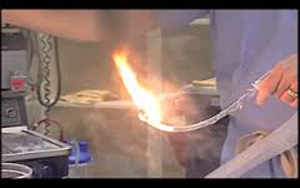If there’s one image that stays with you after the International Laser Safety Conference, it’s an image of the blowtorch effect caused by a laser striking an oxygen-filled endotracheal tube.

Another powerful visual is imagining a concerned — and empowered — laser safety officer walking away from a potentially dangerous operating room situation if a laser surgery seems about to go awry.
Yet another indelible image is picturing a 53-year-old grandmother undergoing a routine 10-minute laser procedure to remove vocal cord polyps — only to have her airway seared after a series of apparent educational and procedural lapses.
Some might say pointing out such dire occurrences is merely an attempt to frighten or be provocative. But there’s really no way to make an inherently horrific occurrence like an airway fire any scarier than it is.
Perhaps more worrisome is the fact that so many more medical LSOs should be certified to take the reins of laser safety in health-care facilities large and small. The need is evident as lasers grow in importance as a surgical and therapeutic tool.
Further evidence of the need for certified medical laser safety officers was provided by attorney Matthew Wojcik of Seattle firm Bullivant Houser Bailey, who detailed the 2012 case of the aforementioned 53-year-old Washington state woman who eventually died from injuries sustained from an airway fire that started about eight-and-a-half minutes into her surgery. According to Wojcik, who represented the laser manufacturer, the surgeon, anesthesiologist and “laser safety nurse” all testified to varying degrees of understanding or even awareness of hospital laser safety protocols, their application and the laser safety committee’s role.
With no CMLSO in place, potential red flags during the procedure — including the laser being set to 18 watts and the oxygen not being turned down from 100 percent to around 30 percent — went unheeded. In fact, the hospital’s previous LSO had left about two years before the incident.
Ultimately, the hospital reached a $12 million settlement with the patient before trial; the patient was awarded $18 million after a trial. (The laser manufacturer was dismissed from the lawsuit prior to trial; the maker of the endotracheal tube was spared from blame in the trial.)
And to think that it might only have cost about $3,500 to properly train and certify a CMLSO who could have been empowered enough to notice anomalies in the procedure and address them — or even postpone the surgery.
It seems hard to argue that the added insurance of naming, training and certifying a CMLSO is worth the cost, given the potentially severe toll a laser surgery gone wrong might take.
A quick look at the list of dozens of CMLSOs certified by the Board of Laser Safety shows that many facilities across the U.S. are committed to investing in the soundness of laser policies and procedures. And yet, a recent survey by UHS Surgical Services indicated that about 40 percent of the 266 health-care facilities responding did not have an LSO or safety program in place.
Where do you stand? Is certifying a medical LSO essential or a luxury?
Geoff is LIA’s communications director. Contact him at ggiordano@lia.org to share your experiences with lasers, sound off on issues regarding any facet of laser technology, suggest stories or offer your commentary with a guest article or blog post.





